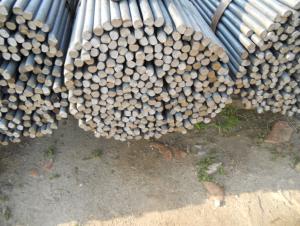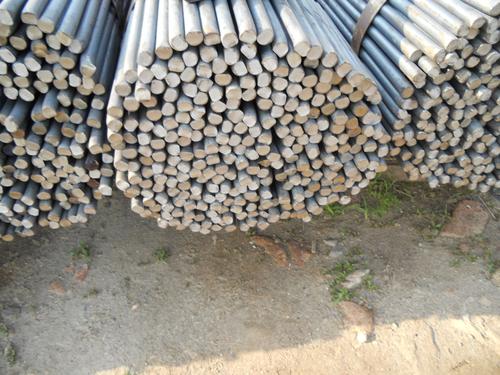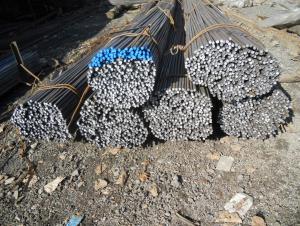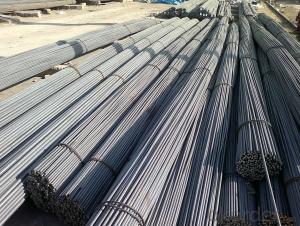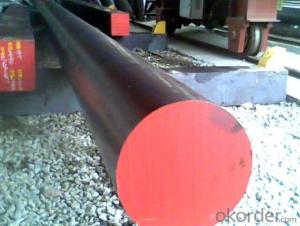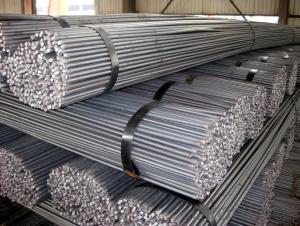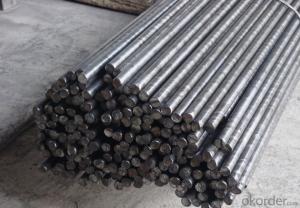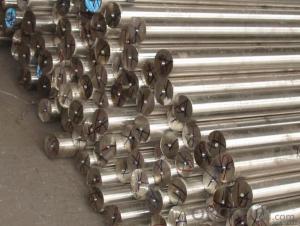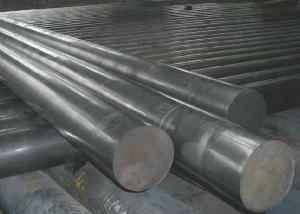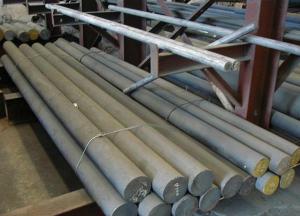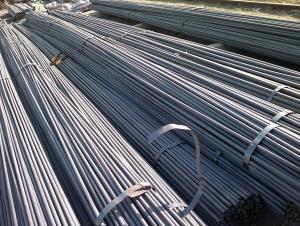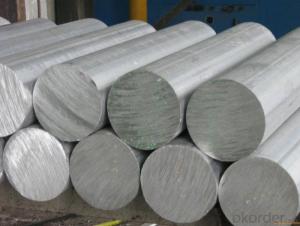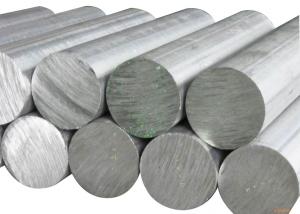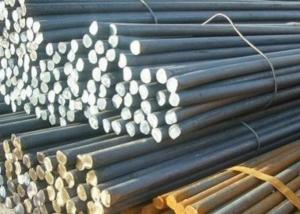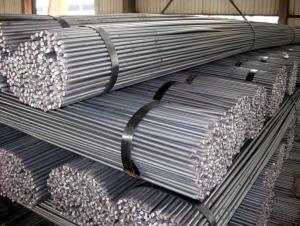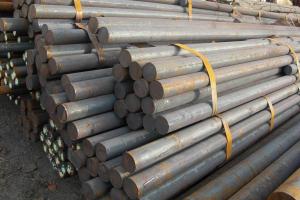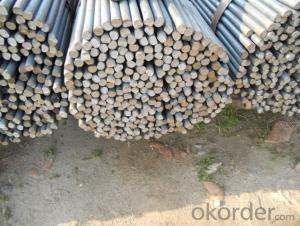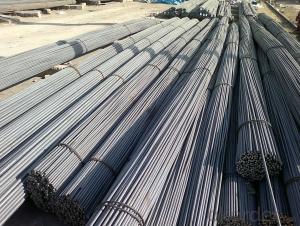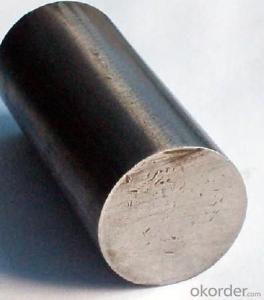Steel Round Bar
- Loading Port:
- China Main Port
- Payment Terms:
- TT OR LC
- Min Order Qty:
- -
- Supply Capability:
- -
OKorder Service Pledge
OKorder Financial Service
You Might Also Like
Specifications of Steel Round Bar:
1. Standard: GB
2. Grade: Q345
3. Invoicing on theoretical weight or actual weight as customer’s request
4. Shape: Round bar, solid bar of steel with circular section
5. Technique: Hot rolled
Size:
| Size (mm) | Section Area (cm2) | Mass (Kg/m) |
| 15 | 176.625 | 1.39 |
| 16 | 200.96 | 1.58 |
Packaging & Delivery of Steel Round Bar:
Packaging Detail: Standard seaworthy packing or as customer required; all goods are packed in bundle with steel strips and shipped by break bulk vessel or container
Delivery Detail: 45 days
Trade terms: FOB, CFR, CIF or as customer required
MOQ: 25 tons per specification; we can negotiate the quantity if the specification is normal or we have stock of one specification.
Weight: The price invoicing on theoretical weight basis or actual weight basis depends on customer’s request.
Shipment: The shipment of bulk break or container is depends on customer’s request.
Documents given: Full set (3/3) of original clean on board bill of lading; Original signed commercial invoice, in 3 originals and 3 copies; Original packing list in 3 originals and 3 copies; Policy of insurance; Certificate of origin and what the target market needs.
* If you would like to get our price, please inform us the size, standard/material and quantity. Thank you very much for your attention.
- Q: What are the corrosion resistance properties of steel round bars?
- Steel round bars have excellent corrosion resistance properties due to the presence of alloying elements such as chromium, nickel, and molybdenum. These elements form a protective oxide layer on the surface of the steel, preventing the metal from coming into contact with corrosive substances. Additionally, stainless steel round bars are highly resistant to rust and corrosion caused by exposure to moisture, chemicals, and atmospheric conditions, making them suitable for various applications in industries such as construction, marine, and manufacturing.
- Q: Can steel round bars be used in the energy industry?
- Yes, steel round bars can be used in the energy industry. Steel round bars are commonly used in various applications within the energy industry due to their high strength, durability, and resistance to corrosion. They are used in the construction of power plants, oil rigs, pipelines, and other energy infrastructure projects. Steel round bars are also used in the manufacturing of machinery and equipment used in the energy industry, such as turbines, generators, and pumps. Additionally, steel round bars are often utilized in the production of renewable energy technologies, including wind turbines and solar power systems. Overall, steel round bars are a versatile and reliable material that can effectively meet the demanding requirements of the energy industry.
- Q: What is the difference between common wire and high-speed wire?
- The universal wire and high speed wire are the wire rods (bars) of the rolling mechanism.High wire: refers to the use of high-speed torsion mill rolling wire rod. The rolling speed of 80-160 M / s, each weight (disc) in 1.8-2.5 tons, tolerance of high precision (up to 0.02mm), in the rolling process by adjusting the process parameters (especially in the cooling line) to ensure the different requirements for the product.
- Q: Can steel round bars be used in the manufacturing of cylinders?
- Yes, steel round bars can be used in the manufacturing of cylinders. Steel round bars are commonly used in various industries, including automotive, aerospace, and manufacturing, due to their high strength and durability. In the case of manufacturing cylinders, steel round bars can be a suitable material choice for constructing the cylindrical body of the cylinder. The steel round bars can be machined, forged, or rolled into the desired shape and then welded or fastened together to form the cylindrical structure. The use of steel round bars ensures a strong and sturdy construction, which is essential for the safe and efficient functioning of cylinders in various applications.
- Q: What are the advantages of using tungsten-alloy steel round bars?
- Tungsten-alloy steel round bars offer several advantages over other materials, making them a popular choice in various industries. Firstly, tungsten-alloy steel round bars have exceptional strength and durability. The addition of tungsten to the steel composition significantly improves its hardness and toughness, making it highly resistant to wear, deformation, and fatigue. This enhanced strength ensures that tungsten-alloy steel round bars can withstand heavy loads and high-pressure applications, making them ideal for use in industries such as aerospace, automotive, and construction. Another advantage of using tungsten-alloy steel round bars is their excellent heat resistance. Tungsten has one of the highest melting points among all elements, making it highly suitable for applications that involve extreme temperatures, such as furnace parts, cutting tools, and high-speed machinery. The heat resistance of tungsten-alloy steel round bars allows them to maintain their structural integrity and performance even in demanding environments, minimizing the risk of deformation or failure. Furthermore, tungsten-alloy steel round bars have superior corrosion resistance. The addition of tungsten to the steel alloy forms a protective oxide layer on the surface, which acts as a barrier against corrosive elements, moisture, and chemicals. This corrosion resistance makes tungsten-alloy steel round bars ideal for applications in marine environments, chemical processing plants, and oil and gas industries, where exposure to corrosive substances is common. Additionally, tungsten-alloy steel round bars provide excellent machinability. The hardness and toughness of these bars make them easy to shape, cut, and drill, allowing for precise machining and tight tolerances. This machinability makes tungsten-alloy steel round bars suitable for manufacturing intricate components and parts that require high precision and accuracy. Lastly, tungsten-alloy steel round bars have a high density, which gives them unique properties such as improved radiation shielding capabilities. This makes them valuable in industries where radiation protection is crucial, such as nuclear power plants, medical equipment, and aerospace applications. In conclusion, the advantages of using tungsten-alloy steel round bars include exceptional strength and durability, excellent heat resistance, superior corrosion resistance, excellent machinability, and high density for radiation shielding. These advantages make tungsten-alloy steel round bars a reliable and versatile choice for various industries, ensuring optimal performance and longevity in challenging environments.
- Q: Are steel round bars available in different diameters?
- Yes, steel round bars are available in a variety of diameters to suit different applications and requirements.
- Q: Can steel round bars be used for making interior components?
- Yes, steel round bars can be used for making interior components. They are often used in various applications such as handrails, furniture, fixtures, and decorative elements due to their strength, durability, and versatility.
- Q: What are the different types of steel round bar surface treatments?
- Steel round bars can undergo various surface treatments to enhance their appearance, durability, and resistance to corrosion. Some commonly used treatments are: 1. Hot-dip galvanizing: Immerse the steel round bar in molten zinc to create a protective zinc coating, preventing rust and corrosion. Ideal for outdoor applications. 2. Electroplating: Apply a layer of another metal, like chrome or nickel, to the steel round bar. Improves appearance and corrosion resistance. 3. Powder coating: Electrostatically apply a dry powder to the surface, then cure it under heat. Creates a hard, durable, and attractive finish resistant to chipping, scratching, and fading. 4. Passivation: Chemically remove impurities from the surface, leaving a clean and corrosion-resistant layer. Commonly used for enhancing rust resistance in stainless steel bars. 5. Black oxide coating: Form a thin layer of black iron oxide on the surface. Provides mild corrosion resistance and a sleek black appearance. 6. Shot blasting: Propel abrasive materials at high speeds onto the surface to remove impurities or scale. Improves appearance and promotes better coating adhesion. 7. Acid pickling: Immerse the bar in an acid bath to remove scale and impurities, leaving a clean surface free from contaminants. These treatments are just a few examples of what can be done to steel round bars. The choice depends on factors such as the bar's intended use, desired appearance, and required corrosion resistance level.
- Q: What are the different shapes available for steel round bars?
- Steel round bars are available in various shapes to suit different applications. The most common shapes include: 1. Round: This is the most basic and widely used shape for steel round bars. It is cylindrical in shape and has a circular cross-section. Round bars are used in a wide range of industries such as construction, automotive, and manufacturing. 2. Square: Square steel round bars have a square cross-section. They are often used in applications that require added strength and stability, such as structural support columns, fences, and ornamental ironwork. 3. Hexagonal: Hexagonal steel round bars have six sides and a hexagonal cross-section. They offer a good balance of strength and versatility and are commonly used in applications such as machine parts, fasteners, and tooling. 4. Flat: Flat steel round bars have a rectangular cross-section with a narrow width and thick height. They are commonly used in construction and manufacturing for applications such as braces, brackets, and supports. 5. Half-round: Half-round steel round bars have a semi-circular cross-section. They are often used in architectural and decorative applications such as handrails, edging, and trim work. These are some of the most common shapes available for steel round bars. The choice of shape depends on the specific requirements of the application, including strength, stability, and aesthetics.
- Q: Can steel round bars be used in the production of flanges?
- Yes, steel round bars can be used in the production of flanges. Round bars made of steel are commonly used as raw materials in the manufacturing process of flanges. These round bars are often machined, forged, or rolled into the desired flange shape. Steel round bars offer several advantages in the production of flanges, including high strength, durability, and resistance to corrosion. They can be easily fabricated and machined to meet specific size and dimensional requirements. Steel round bars are widely utilized in various industries, such as oil and gas, petrochemical, power generation, and construction, for producing flanges that are used in piping systems to connect pipes or equipment.
Send your message to us
Steel Round Bar
- Loading Port:
- China Main Port
- Payment Terms:
- TT OR LC
- Min Order Qty:
- -
- Supply Capability:
- -
OKorder Service Pledge
OKorder Financial Service
Similar products
Hot products
Hot Searches
Related keywords
